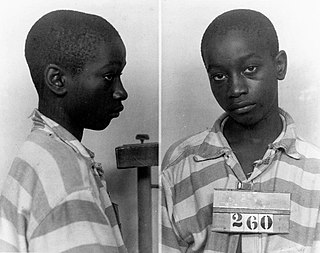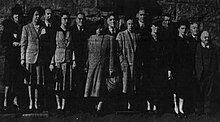
The Mountain Meadows Massacre was a series of attacks during the Utah War that resulted in the mass murder of at least 120 members of the Baker–Fancher wagon train. The massacre occurred in the southern Utah Territory at Mountain Meadows, and was perpetrated by settlers from the Church of Jesus Christ of Latter-day Saints involved with the Utah Territorial Militia who recruited and were aided by some Southern Paiute Native Americans. The wagon train, made up mostly of immigrant families from Arkansas, was bound for California, traveling on the Old Spanish Trail that passed through the Territory.

Leo Max Frank was an American lynching victim convicted in 1913 of the murder of 13-year-old Mary Phagan, an employee in a factory in Atlanta, Georgia where he was the superintendent. Frank's trial, conviction, and unsuccessful appeals attracted national attention. His kidnapping from prison and lynching became the focus of social, regional, political, and racial concerns, particularly regarding antisemitism. Modern researchers generally agree that Frank was wrongly convicted.

Dennis Lynn Rader, also known as BTK, is an American serial killer who murdered at least 10 people in Wichita and Park City, Kansas, between 1974 and 1991. Although he occasionally killed or attempted to kill men and children, Rader typically targeted women. His victims were often bound, sometimes with objects from their homes, and either suffocated with a plastic bag or manually strangled with a ligature. In addition, he stole keepsakes from his female victims, including underwear, driver's licenses, and personal items.

Ottis Elwood Toole was an American serial killer who was convicted of six counts of murder. Like his companion Henry Lee Lucas, Toole made confessions which resulted in murder convictions, and which he later recanted. The discrediting of the case against Lucas for crimes for which Toole had offered corroborating statements created doubts as to whether either was a genuine serial killer or, as Hugh Aynesworth suggested, both were merely compliant interviewees whom police used to clear unsolved murders from the books.

Marie Windsor was an American actress known for her femme fatale characters in the classic film noir features Force of Evil, The Narrow Margin and The Killing. Windsor's height created problems for her in scenes with all but the tallest actors. She was the female lead in so many B movies that she became dubbed the "Queen" of the genre.

Anita Lorraine Cobby was a 26-year-old Australian woman from Blacktown, New South Wales, who was kidnapped while walking home from Blacktown railway station just before 10:00 p.m. on 2 February 1986, and subsequently sexually assaulted and murdered.

The murder of Karmein Chan is an Australian child murder case in which a 13-year-old Chinese-Australian girl was abducted at knifepoint from her home in Templestowe, Victoria, during the night of 13 April 1991. Karmein's body was discovered at Edgars Creek in the suburb of Thomastown on 9 April 1992; the prime suspect for her abduction and murder is an unidentified serial child rapist known as "Mr Cruel", who had abducted and sexually assaulted a minimum of three prepubescent and adolescent girls in circumstances markedly similar to Karmein in the years prior to her abduction.

Reed Hadley was an American film, television and radio actor.
Richard Jason Ofshe is an American sociologist and professor emeritus of sociology at the University of California, Berkeley. He is known for his expert testimony relating to coercion in small groups, confessions, and interrogations.

The towpath murders are a double murder which occurred upon a section of towpath between Teddington Lock and Eel Pie Island in Richmond upon Thames, London, England, on 31 May 1953. The victims were two teenage girls named Christine Reed and Barbara Songhurst who were ambushed by a lone individual as they cycled to their respective homes in Hampton Hill and Teddington. Both girls were overpowered, then violently raped and murdered before their bodies were discarded in the River Thames. The perpetrator, 21-year-old Alfred Charles Whiteway, was convicted of both murders in a trial held at the Old Bailey before Mr Justice Hilbery that October; he was hanged at Wandsworth Prison on 22 December 1953.

George Junius Stinney Jr. was an African American boy who, at the age of 14 was convicted and then executed in a proceeding later vacated as an unfair trial for the murders of two young white girls in March 1944 – Betty June Binnicker, age 11, and Mary Emma Thames, age 8 – in his hometown of Alcolu, South Carolina. He was convicted, sentenced to death, and executed by electric chair in June 1944, thus becoming the youngest American with an exact birth date confirmed to be both sentenced to death and executed in the 20th century.
Crime in Omaha, Nebraska has varied widely, ranging from Omaha's early years as a frontier town with typically widespread gambling and prostitution, to civic expectation of higher standards as the city grew, and contemporary concerns about violent crimes related to gangs and dysfunctions of persistent unemployment, poverty and lack of education among some residents.
There have been notable instances of crime in the American city of Akron, Ohio. A rioting mob in 1900 destroyed several public buildings in their attempts to gain access to the suspect in a child sex attack. In the early 20th century a Black Hand gang led by Rosario Borgio ran an extortion racket; attempts by the police to suppress these activities led to the killing of several policemen and the execution of Borgio. Race riots broke out in 1968 when police were confronted by the inhabitants of the Wooster Avenue area.
Ell Persons was a black man who was lynched on 22 May 1917, after he was accused of having raped and decapitated a 15-year-old white girl, Antoinette Rappel, in Memphis, Tennessee, United States. He was arrested and was awaiting trial when he was captured by a lynch party, who burned him alive and scattered his remains around town, throwing his head at a group of African Americans. A large crowd attended his lynching, which had the atmosphere of a carnival. No one was charged as a result of the lynching, which was described as one of the most vicious in American history, but it did play a part in the foundation of the Memphis chapter of the NAACP.

In Forsyth County, Georgia, in September 1912, two separate alleged attacks on white women in the Cumming area resulted in black men being accused as suspects. First, a white woman reportedly awoke to find a black man in her bedroom; then days later, a white teenage girl was beaten and raped, later dying of her injuries.

Joan Valerie was an American actress, who appeared mainly in B movies in the late 1930s and 1940s.

Margaret Martin was a resident of Kingston, Pennsylvania, United States, who went missing on December 17, 1938, and was found dead in Wyoming County, Pennsylvania, several days later. Martin was a recent graduate of the Wilkes-Barre Business College. On December 17, 1938, she met an unknown man who claimed to be offering her a secretarial job, and was never seen alive again. Her body was discovered in the wilderness 25 miles (40 km) away by a hunter four days later. Martin's death resulted in a lengthy manhunt. Numerous suspects were examined, but no one was ever convicted of the crime. As of 2024, it remains an unsolved case.

Sara Anne Wood was a twelve-year-old American girl who disappeared while riding her bicycle home from Norwich Corners Church in Sauquoit, New York. She is believed to have been abducted less than half a mile from her own home by convicted child killer Lewis Stephen Lent Jr.

Philip Joseph Hughes Jr. known as The East Bay Strangler, is an American convicted serial killer. He killed at least three young women in Contra Costa County throughout the 1970s with the help of his ex-wife, Suzanne Perrin.

In August 1989, Lawrence John DeLisle killed his four children by driving the family station wagon into the Detroit River in Wyandotte, Michigan. A jury found DeLisle guilty of four counts of first-degree murder after a trial in June 1990. In year-end polls of Associated Press newspapers, the DeLisle case ranked as the No. 7 news story in Michigan in 1989 and the No. 6 story of 1990.



















